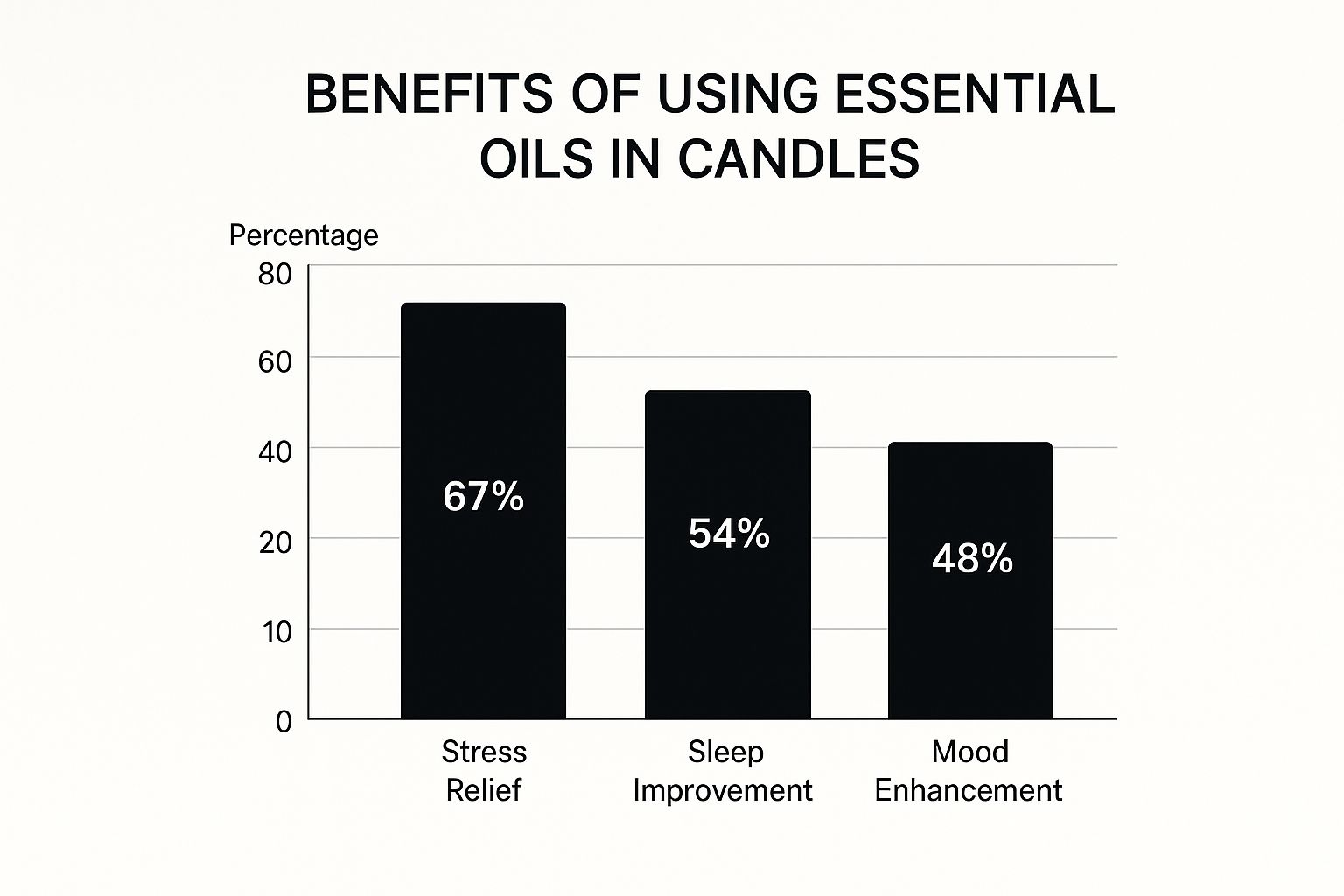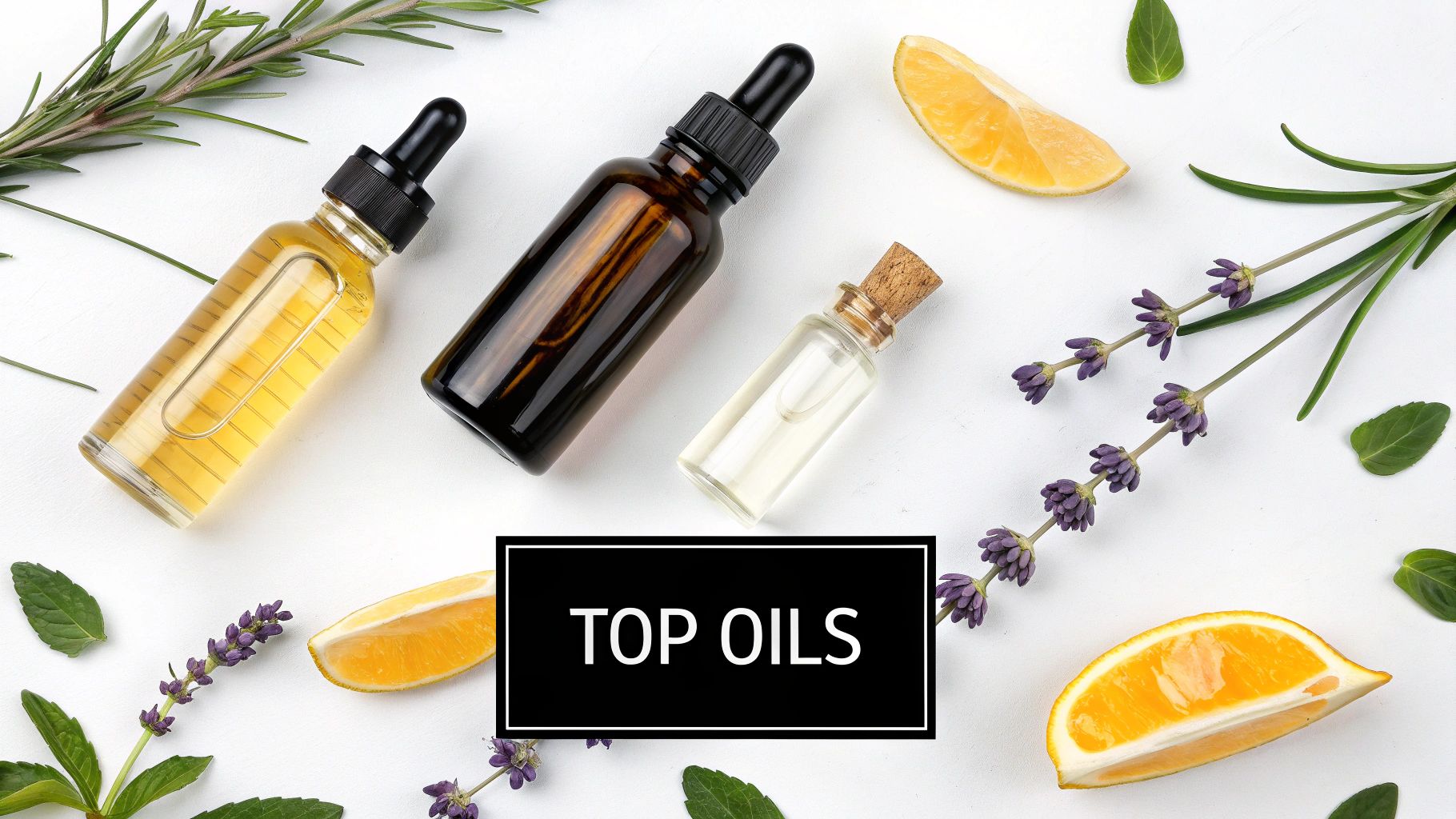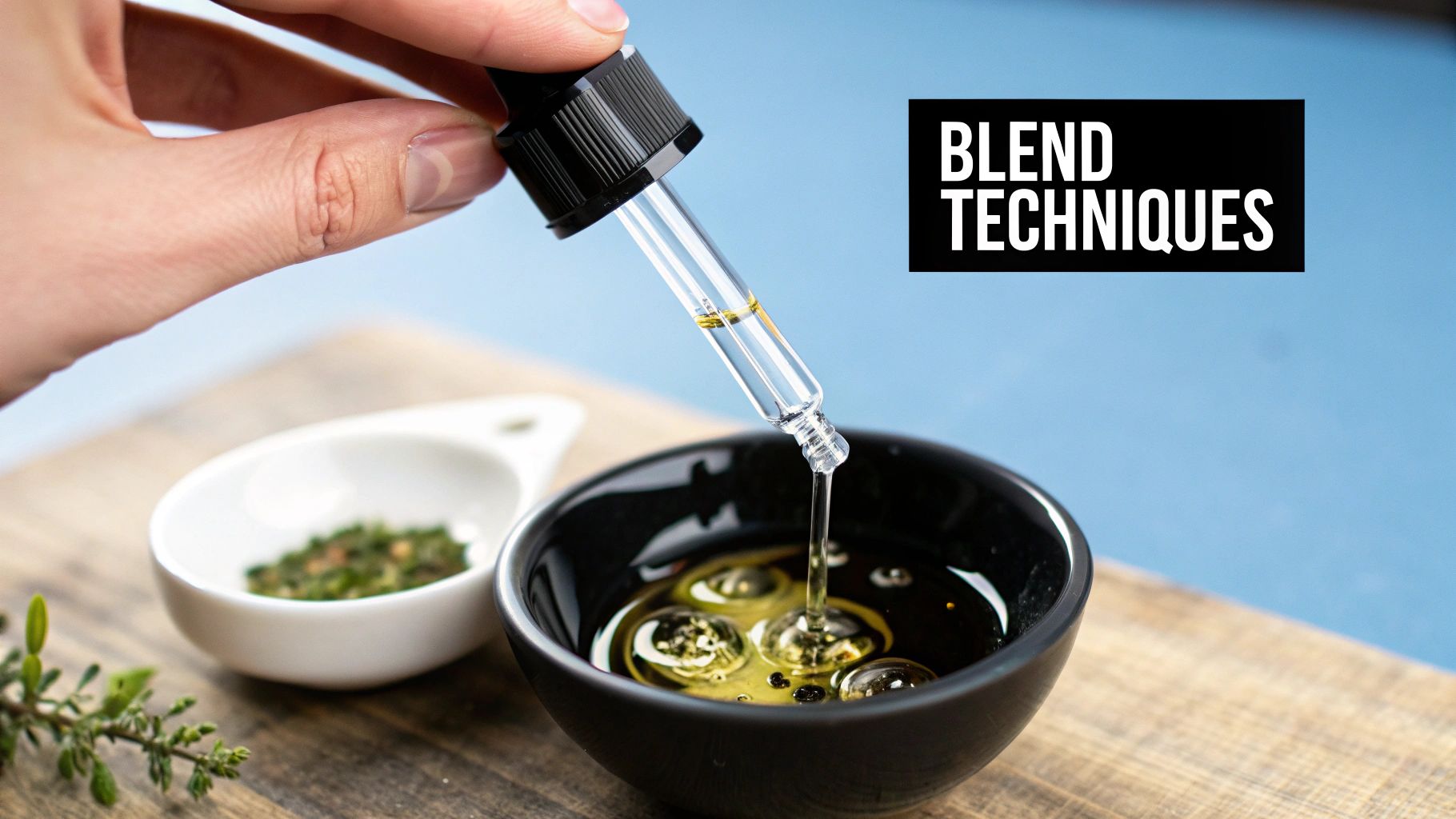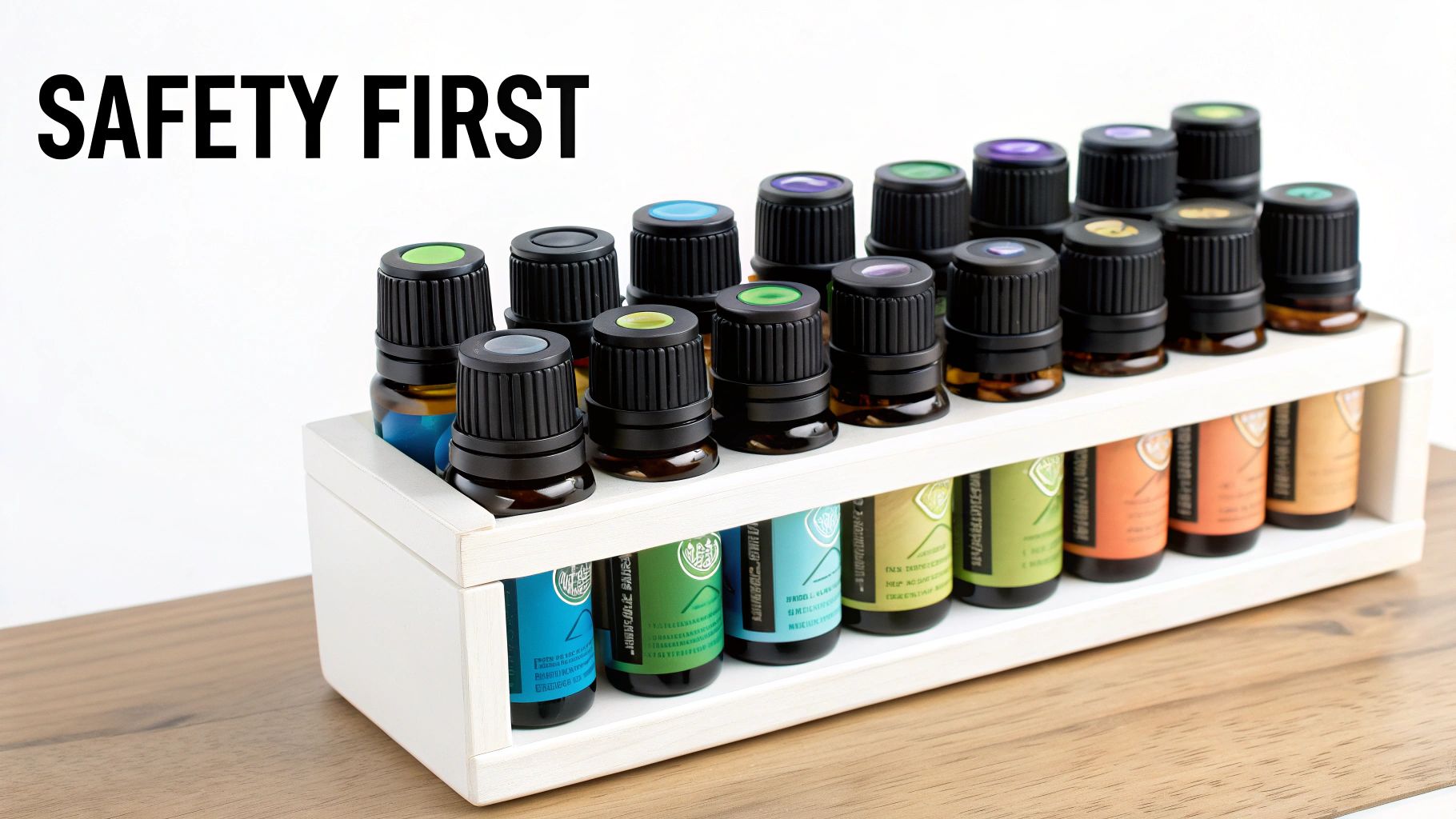Essential Oil for Candle Making: Your Complete Guide
Why Essential Oils Change Everything About Candle Making
Imagine walking into a room and being greeted by a scent that feels real, grounding, and genuinely uplifting. Not the artificial, often overwhelming fragrance of mass-produced candles, but something that makes you want to breathe deeper. This is the distinct experience of using an essential oil for candle making. It's more than just swapping ingredients; it’s a fundamental shift in what a candle can be and do.
Unlike synthetic fragrance oils, which are lab-created compounds designed to mimic scents, essential oils are pure, concentrated extracts from plants. This distinction is vital. When you craft a candle with lavender essential oil, you’re not just creating a “lavender-scented” product. You're capturing the authentic botanical essence of the plant itself. It's an authenticity your customers can truly feel, creating a connection that goes beyond just a pleasant aroma. Think of it as the difference between a picture of a forest and an actual walk among the trees.
From Scent to Experience
The real magic happens when these natural oils transform a person's environment. A candle made with a blend of sandalwood and patchouli doesn’t just smell warm and earthy; it can create a tangible sense of calm and centeredness. This shift from simple fragrance to a therapeutic experience is what can elevate your handmade candles from a hobby project to a premium, sought-after product. Many successful candle makers have built their brands around this very idea, offering customers not just a decorative item, but a genuine tool for wellness.
This growing desire for natural, high-quality ingredients is a significant force in the market. The U.S. scented candle market was valued at $145 million in 2022, and North America holds a commanding 33% of the global revenue share. Consumers are becoming more discerning, carefully reading labels and choosing products that align with a natural lifestyle. You can explore more of these market trends in the scented candle industry to see for yourself. By choosing essential oils, you're meeting this demand head-on, positioning your candles as high-quality, authentic, and genuinely beneficial—which is how you stand out in a crowded marketplace.
Finding Your Perfect Essential Oil Match
Let’s be real for a moment: not every essential oil is destined for a life in a candle. I learned this the hard way, after splurging on expensive oils that smelled incredible in the bottle but completely ghosted me once they hit hot wax. Picking the right essential oil for candle making is less about your favourite scent and more about how it behaves under pressure—or in this case, heat.
Some oils have a low flashpoint, which is the temperature where they can vapourise and become flammable. This makes them not just ineffective but also a potential safety risk. Beyond that, it's all about performance. Citrus oils like lemon and orange, for instance, are known for their low flashpoints and light molecular structure. This means they tend to “burn off” in hot wax, leaving you with a scent that's barely a whisper. On the flip side, strong base notes like sandalwood, cedarwood, and patchouli have higher flashpoints and a heavier structure, which helps anchor your fragrance for a beautiful, lasting aroma.
Matching Oils to Your Goals
The real artistry comes from knowing how different oils can shape an experience. Are you aiming to create a candle that helps someone unwind after a hectic day? Or perhaps you're after a bright, energizing scent perfect for a home office? Your choice of oil sets the entire mood. It's no secret that people often gravitate towards essential oil candles for their wellness properties. This chart highlights some of the most popular benefits people look for.

As the data shows, stress relief (67%) is the top reason people seek out essential oil candles, with sleep and mood enhancement following closely. This insight is gold because it helps you choose oils that genuinely connect with what your customers want, like lavender for relaxation or bergamot for an uplifting boost.
To help you get started, here’s a quick-reference table that compares some popular essential oils, detailing their flashpoints, scent throw, and best uses in candle making.
| Essential Oil | Flashpoint (°F) | Scent Throw | Best Use | Blending Notes |
|---|---|---|---|---|
| Lavender | 165°F (74°C) | Strong | Relaxation, Sleep | Blends well with almost anything, especially citrus and woodsy scents. |
| Peppermint | 158°F (70°C) | Strong | Energizing, Focus | Can be overpowering; use sparingly. Pairs nicely with eucalyptus and rosemary. |
| Eucalyptus | 120°F (49°C) | Medium | Cleansing, Invigorating | Has a lower flashpoint, so add at a lower wax temp. Great with mints. |
| Cedarwood | >200°F (93°C) | Medium | Grounding, Calming | Excellent base note. Adds depth to floral and citrus blends. |
| Sandalwood | >200°F (93°C) | Light-Medium | Meditation, Luxury | A precious, subtle base note. Complements florals like jasmine and rose. |
| Lemon | 115°F (46°C) | Light | Uplifting, Cleaning | Burns off easily. Best used in a blend with higher flashpoint oils to anchor it. |
| Bergamot | 136°F (58°C) | Medium | Mood-Boosting | A versatile top note that brightens up woody and spicy scents. |
This table illustrates how an oil’s properties directly impact its performance in a candle. Notice how oils with higher flashpoints, like Cedarwood and Sandalwood, are often recommended as base notes, while those with lower flashpoints, like Lemon, need a little help from other oils to stick around.
Considering Value and Blending
Let's talk about the practical side: cost. Some oils, such as true rose or sandalwood, come with a hefty price tag that might not be feasible for every candle project. A smart and budget-friendly approach is to use these premium oils as accent notes in a blend. You can let a more affordable oil, like lavender or cedarwood, form the core of the scent, while the pricier oil adds that touch of complexity and luxury.
Experimenting with different combinations is genuinely one of the most enjoyable parts of candle making. If you're keen to understand more about how scents play together, you might find our guide on candle fragrance families and discovering your perfect scent helpful. Getting familiar with these categories is a fantastic step toward crafting blends that are both balanced and uniquely yours. Ultimately, the perfect essential oil is one that’s safe to use, smells wonderful when lit, and fits the budget and goals of your project.
Mastering The Ratios That Actually Work
 This is the moment where so many beautiful, handmade candles miss the mark: the scent ratio. It's a tricky balance. Add too little essential oil, and your candle barely whispers its fragrance. Go overboard, and you’ve created an overpowering scent bomb that’s more likely to cause a headache than create a relaxing mood.
This is the moment where so many beautiful, handmade candles miss the mark: the scent ratio. It's a tricky balance. Add too little essential oil, and your candle barely whispers its fragrance. Go overboard, and you’ve created an overpowering scent bomb that’s more likely to cause a headache than create a relaxing mood.
The secret weapon in your candle-making toolkit is understanding fragrance load. This is simply the percentage of essential oil you use compared to the total weight of your wax. Nailing this is the difference between a disappointing dud and a perfectly scented creation, especially when you're using a high-quality essential oil for candle making.
Moving Beyond The 6% Rule
If you've poked around online, you've probably seen the 6% fragrance load rule mentioned everywhere. While it’s a solid place to start, it's definitely not a one-size-fits-all solution. Think of it as a helpful suggestion, not a strict command. Different waxes behave differently; natural waxes like soy, for instance, have a limit. They can typically hold a maximum of 10-12% fragrance oil before the oil begins to separate, creating a "sweaty" look on your finished candle.
Let's break down the math. Say you're pouring a standard 227g (8 oz) soy wax candle and want to test the standard 6% fragrance load. Here’s how you'd calculate it:
- 227g (your wax weight) x 0.06 (the 6% fragrance load) = 13.62g of essential oil.
You would measure out about 14g of your essential oil blend to add to your melted wax. This is exactly why a digital scale is a candle maker's best friend—it takes the guesswork out and gives you consistent, repeatable results every single time.
Adjusting Ratios for Real-World Scenarios
The type of essential oil you use is another huge factor. Not all oils are created equal in terms of scent strength. A deep, earthy oil like patchouli is incredibly potent and needs a lighter touch, while a bright, zesty citrus oil like lemon is much more delicate and might need a higher percentage to make an impact.
For a blend with strong base notes, starting at 6% is wise. For a lighter, more airy scent profile, you might feel more confident pushing that to 8% or even 10%. The ultimate goal is to achieve a wonderful hot throw—that beautiful aroma your candle releases when it's burning—without overloading the wax.
With over 10,000 different candle scents available in the U.S. alone, using essential oils gives you a natural way to craft truly unique and desirable fragrances. This is a big deal in markets like California, a huge player in the U.S. $3.14 billion annual candle industry, where consumers actively seek out natural products. If you want to dive deeper, you can explore more interesting candle market facts to see how these preferences shape the industry. Ultimately, your perfect ratio will be a personal discovery, found by balancing your wax, your specific oils, and the scent strength you love.
Creating Signature Blends That Sell
 This is the moment where candle making truly becomes an art form. Moving beyond basic scents, creating a signature blend is about crafting a fragrance story that unfolds as the candle burns. The real magic behind a memorable blend comes from understanding the structure of top, middle, and base notes—it’s very much like composing a piece of music. Your choice of essential oil for candle making in each of these categories will shape the entire aromatic experience.
This is the moment where candle making truly becomes an art form. Moving beyond basic scents, creating a signature blend is about crafting a fragrance story that unfolds as the candle burns. The real magic behind a memorable blend comes from understanding the structure of top, middle, and base notes—it’s very much like composing a piece of music. Your choice of essential oil for candle making in each of these categories will shape the entire aromatic experience.
Top notes are the first scents that greet you. They are often bright and zesty, like bergamot, or fresh and herbaceous, like peppermint. Because they evaporate quickly, they make a strong first impression but need help to linger. That's where middle notes come in. These form the heart of your fragrance—think calming florals like lavender or warm spices like cinnamon—and they reveal themselves just as the top notes begin to fade. Anchoring the entire scent are the base notes, which are the rich, deep aromas like sandalwood, cedarwood, or patchouli that provide depth and staying power.
Building a Harmonious Blend
A great blend is all about balance. A fantastic and reliable starting point is the 30-50-20 ratio: 30% top notes, 50% middle notes, and 20% base notes. Let's imagine you're making an 8-ounce candle and your total fragrance load is 15g. Using this ratio, your blend would break down like this:
- Top Notes (30% or 4.5g): Bergamot to create a bright, uplifting opening.
- Middle Notes (50% or 7.5g): Lavender to introduce a calming, floral heart.
- Base Notes (20% or 3g): Cedarwood for a warm, woody finish that lasts.
This structure ensures your candle provides a full scent journey. It starts with a fresh burst, mellows into something soft and beautiful, and finally settles into a comforting, long-lasting aroma. It’s absolutely essential to document every experiment. Keep a detailed journal of your recipes, noting the exact grams or drops used. This way, when you finally create that perfect blend your customers can't get enough of, you can replicate it perfectly every time, turning a one-time purchase into a loyal following.
Popular Blend Combinations
To get your creative juices flowing, I’ve put together a table of some tried-and-true combinations that work beautifully for different moods and seasons. Think of these as a launchpad—feel free to tweak the ratios and make them entirely your own.
Here are some popular essential oil blend recipes with ratios and scent profiles to inspire you.
| Blend Name | Primary Oils | Ratios | Scent Profile | Best Season |
|---|---|---|---|---|
| Forest Retreat | Pine, Cedarwood, Rosemary | 4:3:2 | Crisp, woody, and herbaceous | Autumn/Winter |
| Cozy Fireside | Sandalwood, Cinnamon, Patchouli | 4:2:1 | Warm, spicy, and earthy | Winter |
| Morning Mimosa | Sweet Orange, Bergamot, Ginger | 5:3:1 | Bright, zesty, and uplifting | Spring/Summer |
| Summer Garden | Lavender, Geranium, Chamomile | 3:2:1 | Floral, soft, and calming | Summer |
These combinations are designed to evoke specific feelings and settings, from a brisk walk in an autumn forest to a lazy summer afternoon. By mastering these foundational blends, you'll gain the confidence to start inventing your own unique scents that truly represent your brand.
Temperature And Timing Secrets That Make The Difference
 Getting the temperature right is probably the most crucial part of working with an essential oil for candle making. It's the one variable that can truly make or break your scent throw, no matter how much high-quality oil you've poured in. If you add your oils when the wax is scorching hot, their delicate aromatic compounds can simply burn away, leaving you with a perfectly good but unscented candle. On the flip side, add them when the wax is too cool, and they won't bind properly, which can lead to oil separation or a disappointingly weak scent.
Getting the temperature right is probably the most crucial part of working with an essential oil for candle making. It's the one variable that can truly make or break your scent throw, no matter how much high-quality oil you've poured in. If you add your oils when the wax is scorching hot, their delicate aromatic compounds can simply burn away, leaving you with a perfectly good but unscented candle. On the flip side, add them when the wax is too cool, and they won't bind properly, which can lead to oil separation or a disappointingly weak scent.
I like to think of it like cooking with delicate spices; you wouldn’t toss fresh basil into a sizzling-hot pan right off the bat. The same idea applies here. Every wax has its own ideal temperature window for adding fragrance. For soy wax, a favourite for its clean burn, this sweet spot is typically between 79°C and 85°C (175°F - 185°F). This range is just hot enough for the essential oils to mix in completely with the wax molecules, but cool enough to keep their fragile scents intact.
Why Different Oils Need Different Temperatures
Now, this is where it gets a bit more detailed. The oils themselves play a big role in your timing. Lighter, more volatile top notes, like lemon or eucalyptus, have very low flashpoints. Adding these to wax that’s at the 85°C (185°F) mark is a recipe for a weak-smelling candle, as a lot of their scent will just evaporate on contact. For blends that are heavy on these types of oils, I’ve found much better results adding them closer to the 79°C (175°F) mark.
In contrast, sturdy base notes like sandalwood or cedarwood are far more resilient. They actually benefit from being at the slightly higher end of the temperature range to make sure they bond completely. I learned this the hard way when I ruined an entire batch of lavender and bergamot candles. I added the blend at a temperature that was perfect for the lavender but way too high for the delicate bergamot. The final candles had a very flat, one-dimensional scent because the bright top note had all but disappeared.
A simple digital kitchen thermometer will be your most trusted tool for getting this right every time.
- Heat Your Wax: Gently melt your soy wax to about 85°C (185°F).
- Let It Cool: Take it off the heat and let it cool down. This is an important step!
- Add Your Oils: Once the wax hits your target temperature, pour in your essential oils. Stir gently but thoroughly for two full minutes.
This careful timing is what helps the oil molecules grab onto the wax molecules, which sets you up for an amazing hot throw when you finally get to light your beautiful creation.
Solving Common Essential Oil Candle Problems
Even when you follow your recipe to the letter and use the best ingredients, some batches of essential oil candles just don't cooperate. It’s a moment every candle maker knows, but learning how to troubleshoot these little hiccups is what really grows your skills. The trick is to play detective and figure out what’s gone wrong, whether it’s a scent that fades into thin air or a candle that refuses to burn properly.
Diagnosing Poor Scent Throw
The most frequent issue by far is a weak scent throw—that’s the beautiful aroma your candle releases when it's lit. Before you're tempted to just dump more oil into your next batch, pause and ask a few questions. When you added the essential oil for candle making, was the wax at the correct temperature? If your wax is too hot, it can scorch the more delicate aroma compounds, causing them to evaporate before they ever get a chance to mix in.
Another possible cause is your oil blend itself. If you've created a blend heavy on bright, flighty top notes like lemon or sweet orange, it might smell incredible when the candle is unlit but vanish as soon as the wick is burning. You can fix this by anchoring those lighter scents with solid base notes, such as cedarwood or patchouli. For a more detailed look at boosting your candle's aroma, you can check out our guide on how to make candles smell stronger. Sometimes, a small tweak to your blend's balance is all it takes.
Tackling Oil Separation and Discolouration
Have you ever looked at a finished candle and seen tiny beads of oil sweating on the surface? That's a classic case of oil separation, and it's a clear signal that you’ve probably used too much fragrance for your wax to handle. Natural waxes like soy have a limit to how much oil they can absorb, which is typically around 10% to 12% of the total weight. If you go beyond that, the excess oil has no place to go and gets pushed out. The fix is usually as simple as reducing the amount of fragrance oil in your next batch.
Discolouration, like an unexpected yellow or brownish hue, usually points to the essential oils themselves. Vanilla is a well-known culprit, often causing wax to turn a shade of brown over time. Some citrus and spice oils can also react to heat or UV light, changing the final colour of your candle. It’s always a good idea to make a small test candle first to see how your specific blend behaves. This is a smart habit to get into, especially if you're selling your creations. With the U.S. candle market valued at around $3.42 billion in 2024, shoppers have high expectations for quality and consistency. You can discover more insights about candle market trends to get a better feel for what customers are looking for.
Essential Safety Practices For Essential Oil Candle Making
Let's talk about something that isn't the most glamorous part of candle making but is absolutely crucial: safety. When you're working with hot wax and concentrated essential oils, taking precautions isn't just a good idea—it's what separates a careful artisan from a potential fire hazard. This is especially true when you choose an essential oil for candle making, as their natural potency requires a healthy dose of respect.
Your Essential Safety Checklist
First things first: ventilation. Working in a space with good airflow is non-negotiable. Even though essential oils are natural, their fumes can be quite strong and might lead to headaches or a bit of respiratory irritation if you're in an enclosed room for too long. Think of it as giving both you and your creations some fresh air to breathe.
I also never, ever work without my safety glasses. A splash of hot wax can happen in the blink of an eye, and it’s a risk not worth taking. I’d also recommend using a good pair of heat-resistant gloves when you’re handling the melting pot.
Another point to keep in mind is skin sensitivity. Essential oils are powerful, concentrated plant extracts. If they get directly on your skin, they can cause irritation. I've learned that certain oils, like cinnamon and clove, are particularly strong in this regard. I always wear gloves when measuring and mixing my fragrance blends. If a little does happen to spill on your skin, just wash the area right away with soap and water. Proper storage is also a big part of safety—keep your oils and finished candles in a cool, dark place, safely away from sunlight, curious children, and pets.
Ensuring Your Final Product is Safe
Your safety responsibility doesn't end when the candle is poured. It extends all the way to how the final product is used. The National Candle Association has a fantastic set of safety rules that I believe every candle maker should know by heart.
This image highlights basic but vital principles, such as never leaving a lit candle on its own and making sure it's far from anything that could catch fire. These are the exact messages you need to pass on to anyone who enjoys your candles.
A non-negotiable step in my process is burn testing every single new candle recipe. This isn't just about seeing if the scent is strong enough; it’s about making sure the wick behaves properly, the flame stays at a safe height, and the container doesn't get dangerously hot.
Finally, proper labelling ties it all together. Your labels must have clear safety warnings. Include instructions like, "Trim wick to 1/4 inch before each use" and "Burn only on a level, heat-resistant surface." For a deeper dive, you can read more about our safety and candle tips, which will help ensure your beautiful creations are enjoyed as safely as possible.
At Shivora Candles, we build these meticulous safety standards into every single hand-poured soy candle we make. It’s how we ensure you can relax and enjoy their beautiful fragrances with complete peace of mind. Find your next favourite scent at Shivora Candles.
